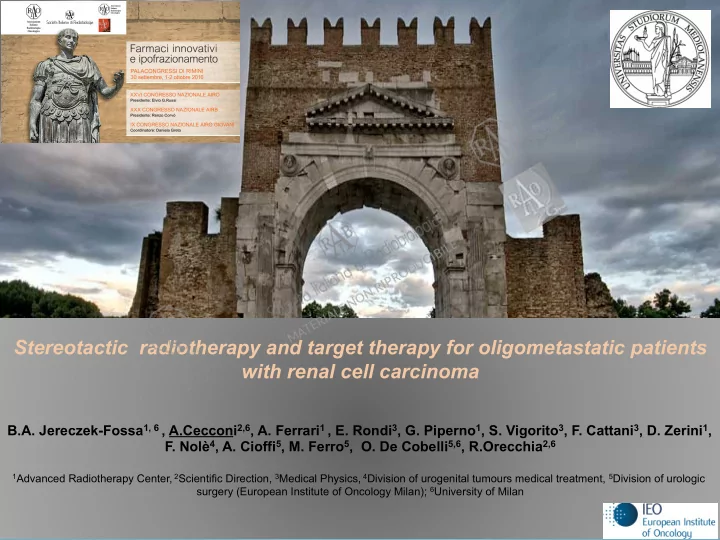

Stereotactic radiotherapy and target therapy for oligometastatic patients with renal cell carcinoma B.A. Jereczek-Fossa 1, 6 , A.Cecconi 2,6 , A. Ferrari 1 , E. Rondi 3 , G. Piperno 1 , S. Vigorito 3 , F. Cattani 3 , D. Zerini 1 , F. Nolè 4 , A. Cioffi 5 , M. Ferro 5 , O. De Cobelli 5,6 , R.Orecchia 2,6 1 Advanced Radiotherapy Center, 2 Scientific Direction, 3 Medical Physics, 4 Division of urogenital tumours medical treatment, 5 Division of urologic surgery (European Institute of Oncology Milan); 6 University of Milan
Once upon time...for radiation oncologist RCC CC was a radioresistant nt disease
Radiotherapy … ????
“ (Oligo)metastatic patients ” The clinical state of oligometastatic disease was proposed in 1995 by Hellman and Weichselbaum. They hypothesized that, in some patients with a limited number of clinically detectable metastatic tumors, the extent of disease exists in a transitional state between localized and widespread systemic disease. In this model, oligometastatic disease has the potential of progressing to widespread metastatic disease. Local control of oligometastases may yield improved systemic control
The high-dose per fraction employed SBRT may be particularly advantageous due to the radiobiological behaviour of RCC. The existence of a dose response relationship using stereotactic radiotherapy has been suggested in previous studies, with improved LC rates with delivery of a higher BED, although these are noncomparative studies
The role of radiotherapy RCC: Palliative To improve pain radiotherapy treatment for To improve LC metastatic disease
Renal cell carcinoma (RCC) prognostic factor ü 50% of pts develop metastatic disease ü The median survival time in metastatic pts is 6-12 months (3 months if brain mts) ü The principal sites are brain, lung, bones JAMA1999 ; 281 : 1628 – 31 J Urol 1986 ; 136 : 376 – 9 J Clin Oncol 1984 ; 2 : 169 – 73 .
… 103 pts (94 bone) were stratified into 3 groups: - High dose (23-24 Gy) - intermediate (21-22 Gy) - Low (18-20 Gy) … Local Control rate after 2 years : 64 % … the median time of failure : 9,6 months Int. J. Radiation Oncology Biol. Phys., Vol. 79, No. 4, pp. 1151–1157, 2011
LOCAL CONTROL AND PAIN RELIEF 3y local PFS … We can consideret the importance of radiosensitization of SBRT for metastatic RCC using targeted therapies 88% with single dose of 24 Gy (46 pts) (sunitinib, sorafenib, bevacizumab) 21% < 24 Gy in single dose(14 pts) 17% hypo in 3-5 or>5 fr (46) … Using RT + targeted therapies could produce synergistic effect and result in more durable responses 69% SBRT improve pain … clinical data for the use of anti-angiogenic agents as a first line monotherapy treatment have been reported from Dana Faber Cancer Center with response rate of 37-9 and 13% respectively in 9 months they have complete pain relief
OUR EXPERIENCE From 2012 to 09/2015 23 pts and 30 lesions treated with SBRT - Cyberknife or VERO- 23 patients affected by RCC (19 men and 4 women) 23 The median age was 62.9 years (range 47-85) Staging and re-staging with CT scan and/or [ 18 F]FDG-PET/ CT Open or robot-assisted laparoscopic radical nephrectomy was performed in all patients (stage pT1- pT3) +/- lymph node dissection (LND) The histotype was clear cell carcinoma in all patients
Patients and methods 13 patients received SRT 13 during systemic therapy: 10 patients received Sunitinib and 3 patients Pazopanib as first- line treatment. 10 patients underwent SRT 10 alone 17 patients were treated for 1 lesion 5 patients for 2lesion 1 for 3 lesions.
The total radiotherapy doses ranged from 10 10 to o 54 54 Gy Gy (1 1 to o 3 3 fr) fr) The median equivalent of the dose (EQD2) was 50.6 Gy Median of 2.7 fractions (range 1-5) Median biological equivalent dose (BED) was 51 Gy
Results The median follow up was 9.4 9.4 months (range 1-36) The progression of the disease was registered in 6 patients at the median of 5.1 months (range 2-8) from the end of SRT 27% (3 % (3 pts pe pts per g r group) > 1 oup) > 12 m months : 5 onths : 5 SR SRT only T only 4 4 SR SRT + STH T + STH 2 PD PD: 1 : 1 sta start STH t STH, 1 , 1 SR SRT (lung le T (lung lesion) sion) No in-field progression was registered. LC was 100 % for all 30 lesions
CONCLUSIONS RCC radiotherapy Using RT + targeted therapies could produce synergistic effect and result in more durable responses Change the view that RCC is a radioresistant disease The high dose/fraction may be advantageous due to radiobiological behaviour The treatment related toxicity and mortality was very low and favourable compared to rates reported for patients undergoing neurosurgery Median follow-up was generally limited, ranging from 5.2 to 16 months in the intracranial setting, and 5 to 52 months in the extracranial setting, this length of follow-up, however, may be sufficient in the metastatic setting
Thanks to IEO multidisciplinary team Grazie per la vost.a a/enzione agnese.cecconi@ieo.it Federico Fellini La dolce vita 1960
Recommend
More recommend